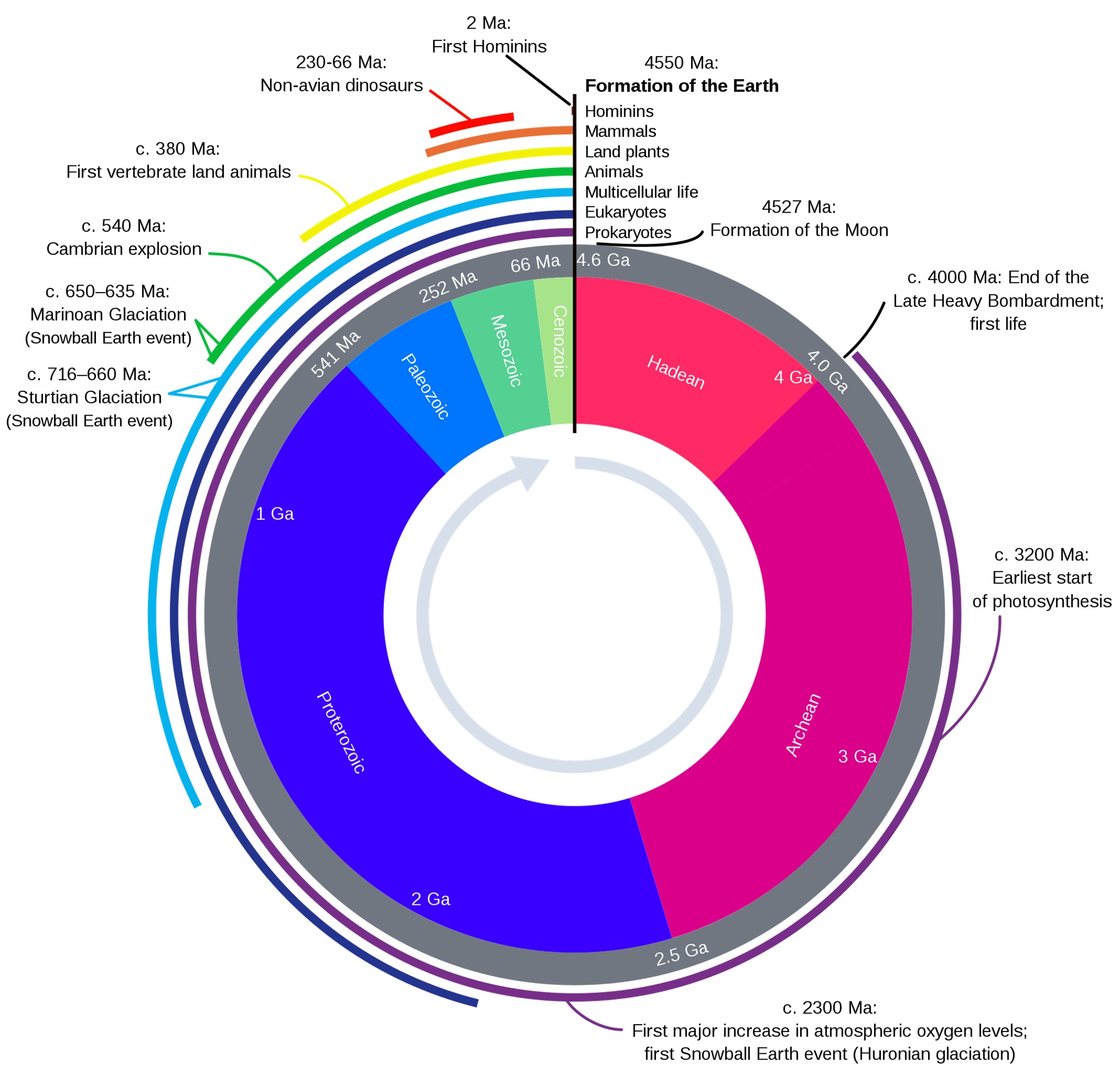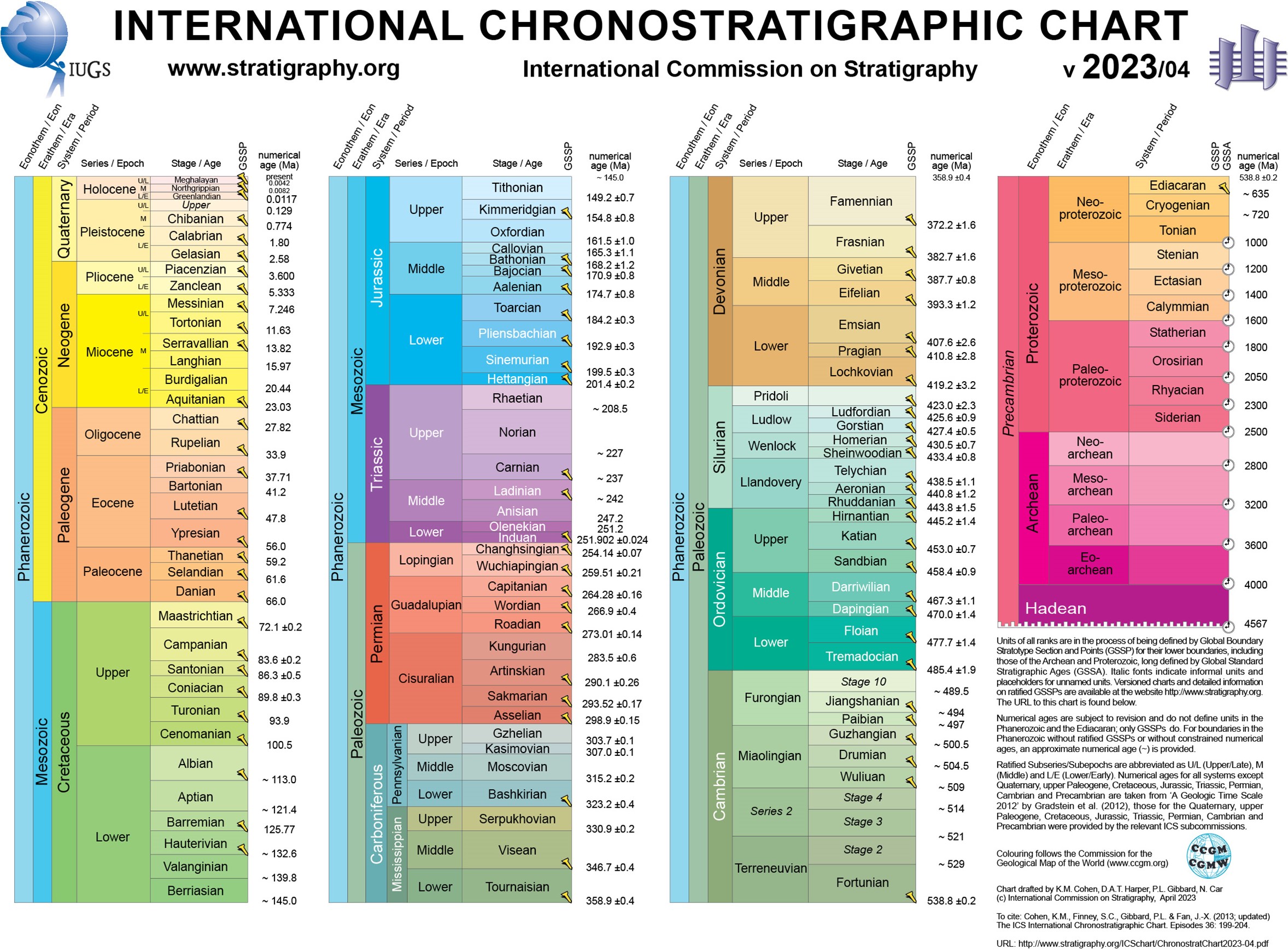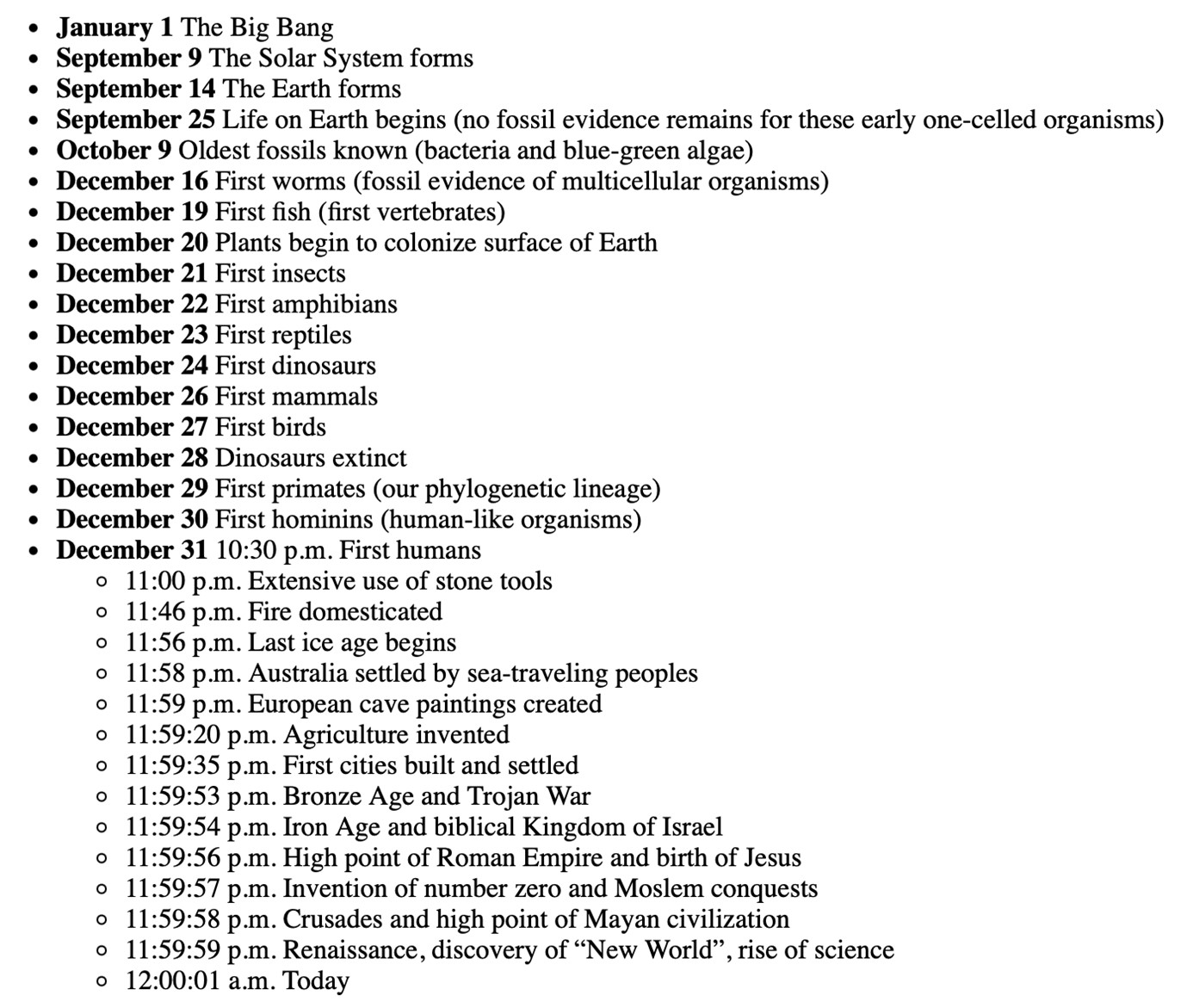
Credit: Woudloper, derivative work: Hardwigg, public domain, via Wikimedia Commons
When the human mind evolved, it only had to process small numbers, like the number of fingers on a hand.
To this day, we base our counting systems on that and use it to grasp very large numbers—with limited success.
So, when scientists needed to make sense of Earth’s 5 billion–year history, they tied it to something concrete: Earth itself.
We started by realizing that Earth’s history is preserved in layers of sedimentary rock. That younger layers were deposited on top of older layers. And that fossils found in those older layers came from earlier animals.
Then we mapped Earth’s history onto those rock layers and fossil periods.
But misunderstandings still occur. You may have seen dioramas in museums of a T. rex attacking a Stegosaurus.
However, the Stegosaurus went extinct 150 million years ago. And the T. rex lived 65 million years ago. That means there is less time separating T. rex and humans than T. rex and Stegosaurus!
Which is almost impossible to comprehend.
So, scientists also compare geologic time to units we can understand. For instance, imagine a 100-yard football field with all of Earth’s history laid upon it.
Early humans appear in the last one-eighth of an inch. And all of civilization is represented by the width of two human hairs.
Pretty humbling to think we’re just a blink of an eye in Earth’s lifetime.
Background
Synopsis: When most humans think of time, we tend to consider minutes, hours, days and years as represented on clocks and calendars. But when earth scientists think of time, they have to think on the scale of millions to billions of years, and their calendar is the geologic time scale. Humans have only existed on Earth for around 0.0066% of its history, so grasping the immensity of deep time is challenging. Comparing relative timing helps with the concept.
- For humans, the immensity of time is hard to understand because our brains evolved to count small groups quickly and to relegate larger groups to the concept of “many.”
- As hunter-gatherers, early humans only needed to keep track of small numbers of things.
- Most of us can readily identify groups of up to four or five without counting. In mathematics, this is called subitizing. Groups larger than four or five require individual counting or grouping into recognizable patterns and multiplying.

An observer may be able to instantly judge (subitize) how many red circles are present without counting them but would find it harder to do so for the greater number of blue circles.
Credit: Averater, CC0, via Wikimedia Commons - Scientific discovery required that humans start to consider larger numbers, and while writing down hundreds, thousands, millions and billions is easy from a logical standpoint, it remains conceptually challenging.
- We can distinguish relatively larger and smaller groups visually but struggle to quantify them in an absolute sense.
- Earth is 4.567 billion years old—that’s 4,567,000,000 years old, just one-third of the time since the Big Bang occurred an astounding 13.8 billion years ago.
- Possibly more difficult to grasp is the fact that Homo sapiens first appeared about 300,000 years ago, so humans have only been on planet Earth for 0.0066% of its existence, about 1/15,000th of deep time.
- From the standpoint of time, we can visualize human lifespans, but even historical and archaeological time in hundreds and thousands of years is hard to register without a relative comparison.
- The Great Pyramid of Giza was completed around 4,600 years ago in 2560 BC.
- Cleopatra was the last active ruler of the Ptolemaic Kingdom of Egypt and ruled for 19 years from 50 to 31 BC.

Left: The Great Pyramid of Giza in 2005.
Right: A marble bust of a Ptolemaic queen, possibly Cleopatra, c. 51–30 BC, located in the Brooklyn Museum
Left Credit: Nina at Norwegian Wikipedia, via Wikimedia Commons
Right Credit: Brooklyn Museum, public domain, via Wikimedia Commons - So, Cleopatra actually lived closer to the AD 2010 completion of Dubai’s Burj Khalifa than she did to the 2560 BC completion of Egypt’s Great Pyramid. Think about that!
- For earth scientists the challenge is greater, extending to millions and billions of years.
- Geologists developed and refined the geologic time scale by trial and error over more than 200 years as a way to characterize parts of Earth’s geologic history based on major geologic and biological events, enabling correlation of rock units and concepts on a global basis.
- In AD 1669, Nicolaus Steno proposed the principle of superposition, that younger rocks overlie older rocks in undisturbed rocks.
- In the late 1700s, James Hutton proposed that rocks could be classified based on their relative ages, producing the first sketches of geologic time scales.
- In the early 1800s, William Smith extended Steno’s ideas into the principle of faunal succession, that fossils in an overlying rock layer are younger than the fossils in a lower layer.
- In the early 1800s, Charles Lyell’s concept of uniformitarianism stated that processes operating today have operated throughout Earth history.
- In the late 1800s and early 1900s, Georges Cuvier proposed the theory of catastrophism that caused the extinction of species, which correlated to major breaks in Earth’s history, demarcated by the geologic time scale.
- In the mid-20th century, the development of radiometric dating allowed researchers to assign absolute ages to rock layers and fossils.
- The geologic time scale will always be a work in progress as scientists continue to discover more about Earth’s history.

The current International Chronostratigraphic Chart is precise but not drawn to scale. As new data is collected and research warrants, the chart is continually updated by the International Commission on Stratigraphy, and the most current version can be found at stratigraphy.org/chart#latest-version.
Credit: International Commission on Stratigraphy- Since 1974, it has been standardized and continually revised by the International Commission on Stratigraphy, based in Norfolk, Virginia, in the United States.
- Today’s geologic time scale subdivides 4.567 billion years of Earth’s history into hierarchical units of time called eons, eras, periods, epochs and ages in descending order of their length—ages belong within epochs, epochs within periods and so on.
- Using relative time to help describe geologic time can be enlightening, similar to the historical surprise about Cleopatra.
- What about Tyrannosaurus rex and Stegosaurus? They did not coexist.

Stegosaurus (left) lived from 155 to 150 million years ago, in the Late Jurassic, dying out around 66 million years before T. rex (right) roamed Earth from 68 to 66 million years ago, in the Late Cretaceous.
Credit: Nobu Tamura (http://spinops.blogspot.com), via Wikimedia Commons- T. rex fossils first show up in Late Cretaceous rocks that are about 68 million years old, and they became extinct 66 million years ago, after a reign of more than 2 million years (somewhat longer than Cleopatra …).
- Stegosaurs died out in the Late Jurassic around 150 million years ago—82 million years before the first T. rex walked the earth.
- So, stegosaurs disappeared 82 million years before T. rexes existed, and T. rexes died out 66 million years ago, meaning less time separates humans from T. rexes than separates T. rexes from stegosaurs.
- Absorb that thought while learning that the oldest dinosaur lived 243 million years ago, 159 million years before the first Tyrannosaurus.
- Scientists have used familiar analogies to help us comprehend deep time, like a football field for Earth’s history.
- On a 100-yard (91 m) football field, mammals first appear on the last yard line, humans show up in the last one-eighth inch (3 mm), and human civilization is just the width of two human hairs.

This fun NPR video rolls out the history of Earth in 4.5 minutes on a football field, illustrating that humans are separated from T. rex by less time than T. rex is separated from Stegosaurus, and the earliest dinosaurs are about twice as far back.
Credit: NPR
- On a 100-yard (91 m) football field, mammals first appear on the last yard line, humans show up in the last one-eighth inch (3 mm), and human civilization is just the width of two human hairs.
- On an even larger and overwhelming scale, Carl Sagan used a calendar year to lay out the hugeness of time in the universe’s history, humans finally appear at 10:30 p.m. on December 31st. Take a deep breath!

Carl Sagan’s Big Bang illustration that maps time since the Big Bang onto a 365-day “cosmic” calendar, first published in his book Dragons of Eden.
Credit: Sagan, C. (1977)
- What about Tyrannosaurus rex and Stegosaurus? They did not coexist.

